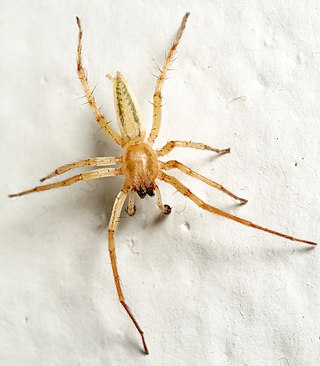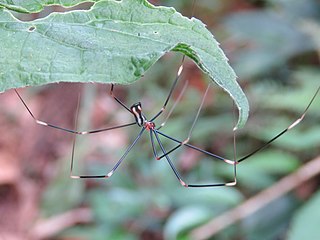
Anyphaenidae is a family of araneomorph spiders, sometimes called anyphaenid sac spiders. They are distinguished from the sac spiders of the family Clubionidae and other spiders by having the abdominal spiracle placed one third to one half of the way anterior to the spinnerets toward the epigastric furrow on the underside of the abdomen. In most spiders the spiracle is just anterior to the spinnerets. Like clubionids, anyphaenids have eight eyes arranged in two rows, conical anterior spinnerets and are wandering predators that build silken retreats, or sacs, usually on plant terminals, between leaves, under bark or under rocks. There are more than 600 species in over 50 genera worldwide.

Wandering spiders (Ctenidae) are a family of spiders that includes the Brazilian wandering spiders. These spiders have a distinctive longitudinal groove on the top-rear of their oval carapace similar to those of the Amaurobiidae. They are highly defensive and venomous nocturnal hunters. Wandering spiders are known to hunt large prey, for example hylid species Dendropsophus branneri. Despite their notoriety for being dangerous, only a few members of Phoneutria have venom known to be hazardous to humans, but the venoms of this family are poorly known, so all larger ctenids should be treated with caution.
Aysha is a genus of anyphaenid sac spiders first described by Eugen von Keyserling in 1891. They are often called "sac spiders" because of the dwellings that they create for themselves to take shelter in. As is true with most other spiders, the pedipalps of the males are much larger than those of the females. They are found throughout South America up to Panama.

Breda is a genus of jumping spiders that was first described by George Peckham & Elizabeth Peckham in 1894.

Acanthoscurria is a genus of tarantulas that was first described by Anton Ausserer in 1871. They are found throughout South America including the countries of Argentina, Bolivia, Brazil, Ecuador, French Guiana, Guyana, Paraguay, Peru, Suriname and Venezuela, plus into the Windward Islands West Indies,.
Osoriella is a genus of South American anyphaenid sac spiders first described by Cândido Firmino de Mello-Leitão in 1922.
Nothroctenus is a genus of South American wandering spiders first described by H. D. Badcock in 1932.
Pikelinia is a genus of South American crevice weavers that was first described by Cândido Firmino de Mello-Leitão in 1946.
Otiothops is a genus of palp-footed spiders that was first described by W. S. MacLeay in 1839.

Mesabolivar is a genus of cellar spiders that was first described by M. A. González-Sponga in 1998.
Metagonia is a genus of cellar spiders that was first described by Eugène Louis Simon in 1893.

Thymoites is a genus of comb-footed spiders that was first described by Eugen von Keyserling in 1884.
Jessica is a genus of South American anyphaenid sac spiders first described by Antônio Domingos Brescovit in 1997.






